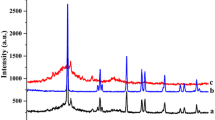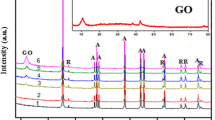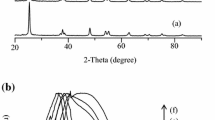Abstract
In this paper, the experimental design methodology was employed for modeling and optimizing the operational parameters of the photocatalytic degradation of a binary dye solution using a fixed photocatalytic compound. The compound used was modified graphite electrode (GE) with graphene oxide (GO) on which TiO2 nanoparticles were immobilized. GO nanoparticle was deposited on graphite electrode (GO-GE) using electrochemical approach. TiO2 nanoparticles were immobilized on GO-GE by solvent evaporation method. A binary solution containing mixture of methylene blue (MB) and acid red 14 (AR14) was chosen as dye model. The degradation intermediates were detected and analyzed using gas chromatography. Effect of different factors on the photocatalytic decolorization efficiency was investigated and optimized using response surface methodology (RSM). The obtained results indicated that the prepared TiO2-GO-CE can decolorize MB with high efficiency (93.43%) at pH 11, dye concentration of 10 mg/L and 0.04 g of immobilized TiO2 on the GO fabricated plates after 120 min of photocatalytic process. It was demonstrated that by modifying GE with GO the stability of the electrode was remarkably enhanced. The ANOVA results (R2 = 0.97 and P value <0.0001 for MB, R2 = 0.96 and P value <0.0001 for AR14) and numerical optimization showed that it is possible to make good prediction on decoloration behavior and save time and energy with less number of experiments using design of experiments (DoE) like the RSM.

Wastewater treatment process









Similar content being viewed by others
References
Hey T, Bajraktari N, Vogel J, Hélix Nielsen C, la Cour JJ, Jönsson K. The effects of physicochemical wastewater treatment operations on forward osmosis. Environ Technol. 2017;38(17):2130–42.
Mohammadi NN, Pajootan E, Bahrami H, Arami M. Magnetization of TiO2 nanofibrous spheres by one-step ultrasonic-assisted electrochemical technique. J Mol Liq. 2018;265:251–9.
Pan Y, Wang J, Sun C, Liu X, Zhang H. Fabrication of highly hydrophobic organic–inorganic hybrid magnetic polysulfone microcapsules: a lab-scale feasibility study for removal of oil and organic dyes from environmental aqueous samples. J Hazard Mater. 2016;309:65–76.
Khue DN, Lam TD, Van Chat N, Bach VQ, Minh DB, Loi VD, et al. Simultaneous degradation of 2,4,6-trinitrophenyl-N-methylnitramine (Tetryl) and hexahydro-1,3,5-trinitro-1,3,5 triazine (RDX) in polluted wastewater using some advanced oxidation processes. J Ind Eng Chem. 2014;20(4):1468–75.
Lin W-C, Yang W-D, Jheng S-Y. Photocatalytic degradation of dyes in water using porous nanocrystalline titanium dioxide. J Taiwan Inst Chem Eng. 2012;43(2):269–74.
Shu Z, Singh A, Klamerth N, McPhedran K, Bolton JR, Belosevic M, et al. Pilot-scale UV/H2O2 advanced oxidation process for municipal reuse water: Assessing micropollutant degradation and estrogenic impacts on goldfish (Carassius auratus L.). Water Res. 2016;101:157–66.
Zhu C, Wang L, Kong L, Yang X, Wang L, Zheng S, et al. Photocatalytic degradation of AZO dyes by supported TiO 2+ UV in aqueous solution. Chemosphere. 2000;41(3):303–9.
Kuvarega AT, Krause RW, Mamba BB. Nitrogen/palladium-codoped TiO2 for efficient visible light photocatalytic dye degradation. J Phys Chem C. 2011;115(45):22110–20.
Gar Alalm M, Tawfik A, Ookawara S. Enhancement of photocatalytic activity of TiO2 by immobilization on activated carbon for degradation of pharmaceuticals. Journal of Environmental Chemical Engineering. 2016;4(2):1929–37.
Rauf M, Meetani M, Hisaindee S. An overview on the photocatalytic degradation of azo dyes in the presence of TiO 2 doped with selective transition metals. Desalination. 2011;276(1):13–27.
Shoabargh S, Karimi A, Dehghan G, Khataee A. A hybrid photocatalytic and enzymatic process using glucose oxidase immobilized on TiO 2/polyurethane for removal of a dye. J Ind Eng Chem. 2014;20(5):3150–6.
Gelover S, Mondragón P, Jiménez A. Titanium dioxide sol–gel deposited over glass and its application as a photocatalyst for water decontamination. J Photochem Photobiol A Chem. 2004;165(1):241–6.
Zhang X, Du AJ, Lee P, Sun DD, Leckie JO. TiO2 nanowire membrane for concurrent filtration and photocatalytic oxidation of humic acid in water. J Membr Sci. 2008;313(1–2):44–51.
Maeng SK, Cho K, Jeong B, Lee J, Lee Y, Lee C, et al. Substrate-immobilized electrospun TiO2 nanofibers for photocatalytic degradation of pharmaceuticals: the effects of pH and dissolved organic matter characteristics. Water Res. 2015;86:25–34.
Xia M, Ye C, Pi K, Liu D, Gerson AR. Cr(III) removal from simulated solution using hydrous magnesium oxide coated Fly ash: optimization by response surface methodology (RSM). Chin J Chem Eng.
Hivechi A, Bahrami SH, Gholami AA. Cellulose fabric with enhanced water absorbance and permeability using microwave radiation: modeling and optimization by RSM. The journal of the Textile Institute. 2019;110(1):117–23.
Nieto-Sanchez AJ, Olivares-Marin M, Garcia S, Pevida C, Cuerda-Correa EM. Influence of the operation conditions on CO 2 capture by CaO-derived sorbents prepared from synthetic CaCO 3. Chemosphere. 2013;93(9):2148–58.
Zinatizadeh AAL, Mohamed AR, Abdullah AZ, Mashitah MD, Hasnain Isa M, Najafpour GD. Process modeling and analysis of palm oil mill effluent treatment in an up-flow anaerobic sludge fixed film bioreactor using response surface methodology (RSM). Water Res. 2006;40(17):3193–208.
Huang W, Xu J, Lu D, Deng J, Shi G, Zhou T. Rational design of magnetic infinite coordination polymer core-shell nanoparticles as recyclable adsorbents for selective removal of anionic dyes from colored wastewater. Appl Surf Sci. 2018;462:453–65.
Mazaheri H, Ghaedi M, Asfaram A, Hajati S. Performance of CuS nanoparticle loaded on activated carbon in the adsorption of methylene blue and bromophenol blue dyes in binary aqueous solutions: using ultrasound power and optimization by central composite design. J Mol Liq. 2016;219:667–76.
Tripathy S, Dash S. Solvation studies of some tailor made α-N,N-dimethylaminostyryl-N-alkyl pyridinium dyes in binary solvent mixtures containing alcohols, hexane, 1,4-dioxane, DCM and acetone. J Mol Liq. 2015;206:29–38.
Fernandez M, Nunell G, Bonelli P, Cukierman A. Batch and dynamic biosorption of basic dyes from binary solutions by alkaline-treated cypress cone chips. Bioresour Technol. 2012;106:55–62.
Ikhsan NI, Rameshkumar P, Pandikumar A, Shahid MM, Huang NM, Kumar SV, et al. Facile synthesis of graphene oxide–silver nanocomposite and its modified electrode for enhanced electrochemical detection of nitrite ions. Talanta. 2015;144:908–14.
Dasgupta J, Singh M, Sikder J, Padarthi V, Chakraborty S, Curcio S. Response surface-optimized removal of reactive red 120 dye from its aqueous solutions using polyethyleneimine enhanced ultrafiltration. Ecotoxicol Environ Saf. 2015;121:271–8.
Cong Y, Long M, Cui Z, Li X, Dong Z, Yuan G, et al. Anchoring a uniform TiO 2 layer on graphene oxide sheets as an efficient visible light photocatalyst. Appl Surf Sci. 2013;282:400–7.
Sun H, Liu S, Zhou G, Ang HM, Tadé MO, Wang S. Reduced graphene oxide for catalytic oxidation of aqueous organic pollutants. ACS Appl Mater Interfaces. 2012;4(10):5466–71.
Nagarjuna R, Challagulla S, Alla N, Ganesan R, Roy S. Synthesis and characterization of reduced-graphene oxide/TiO2/zeolite-4A: a bifunctional nanocomposite for abatement of methylene blue. Mater Des. 2015;86:621–6.
Oladipo AA, Gazi M. Nickel removal from aqueous solutions by alginate-based composite beads: central composite design and artificial neural network modeling. Journal of Water Process Engineering. 2015;8:e81–91.
Podstawczyk D, Witek-Krowiak A, Dawiec A, Bhatnagar A. Biosorption of copper (II) ions by flax meal: empirical modeling and process optimization by response surface methodology (RSM) and artificial neural network (ANN) simulation. Ecol Eng. 2015;83:364–79.
Wu J, Zhang H, Oturan N, Wang Y, Chen L, Oturan MA. Application of response surface methodology to the removal of the antibiotic tetracycline by electrochemical process using carbon-felt cathode and DSA (Ti/RuO 2–IrO 2) anode. Chemosphere. 2012;87(6):614–20.
Vaez M, Zarringhalam Moghaddam A, Alijani S. Optimization and modeling of photocatalytic degradation of azo dye using a response surface methodology (RSM) based on the central composite design with immobilized titania nanoparticles. Ind Eng Chem Res. 2012;51(11):4199–207.
Srinu Naik S, Pydi SY. Optimization of parameters using response surface methodology and genetic algorithm for biological denitrification of wastewater. Int J Environ Sci Technol. 2014;11(3):823–30.
Akerdi AG, Bahrami SH, Arami M, Pajootan E. Photocatalytic discoloration of acid red 14 aqueous solution using titania nanoparticles immobilized on graphene oxide fabricated plate. Chemosphere. 2016;159:293–9.
Xu C, Rangaiah GP, Zhao XS. Photocatalytic degradation of methylene blue by titanium dioxide: experimental and modeling study. Ind Eng Chem Res. 2014;53(38):14641–9.
Bansal P, Sud D. Photodegradation of commercial dye, Procion blue HERD from real textile wastewater using nanocatalysts. Desalination. 2011;267(2):244–9.
Ilinoiu EC, Pode R, Manea F, Colar LA, Jakab A, Orha C, et al. Photocatalytic activity of a nitrogen-doped TiO 2 modified zeolite in the degradation of reactive yellow 125 azo dye. J Taiwan Inst Chem Eng. 2013;44(2):270–8.
Azimi F, Nabizadeh R, Hassanvand MS, Rastkari N, Nazmara S, Naddafi K. Photochemical degradation of toluene in gas-phase under UV/visible light graphene oxide-TiO 2 nanocomposite: influential operating factors, optimization, and modeling. J Environ Health Sci Eng. 2019:1–13.
Bansal P, Singh D, Sud D. Photocatalytic degradation of azo dye in aqueous TiO 2 suspension: reaction pathway and identification of intermediates products by LC/MS. Sep Purif Technol. 2010;72(3):357–65.
Singh RK, Babu V, Philip L, Ramanujam S. Applicability of pulsed power technique for the degradation of methylene blue. Journal of Water Process Engineering. 2016;11:118–29.
Acknowledgements
The author thank to Amirkabir University of Technology for all the supports throughout this study.
Author information
Authors and Affiliations
Corresponding author
Ethics declarations
Conflict of interest
There is not any conflict of interest in this manuscript.
Additional information
Publisher’s note
Springer Nature remains neutral with regard to jurisdictional claims in published maps and institutional affiliations.
Highlights
• Photocatalytic degradation of binary dye solution using TiO2-GO-GE.
• Binary solution was consist of two different dyes including AR14 and MB.
• RSM was used to examine effect of independent factors on dye removal as response.
• The degradation intermediates were detected and analyzed using gas chromatography method.
• Stability and adsorption tests were employed to enhance photocalytic degradation of MB using GO.
Rights and permissions
About this article
Cite this article
Akerdi, A.G., Bahrami, S.H. & Pajootan, E. Modeling and optimization of Photocatalytic Decolorization of binary dye solution using graphite electrode modified with Graphene oxide and TiO2. J Environ Health Sci Engineer 18, 51–62 (2020). https://doi.org/10.1007/s40201-019-00437-z
Received:
Accepted:
Published:
Issue Date:
DOI: https://doi.org/10.1007/s40201-019-00437-z




